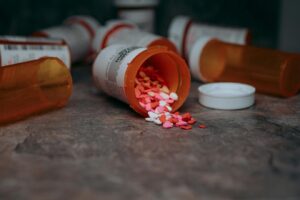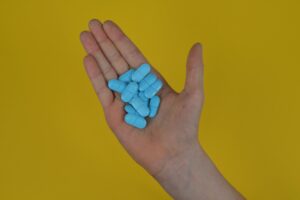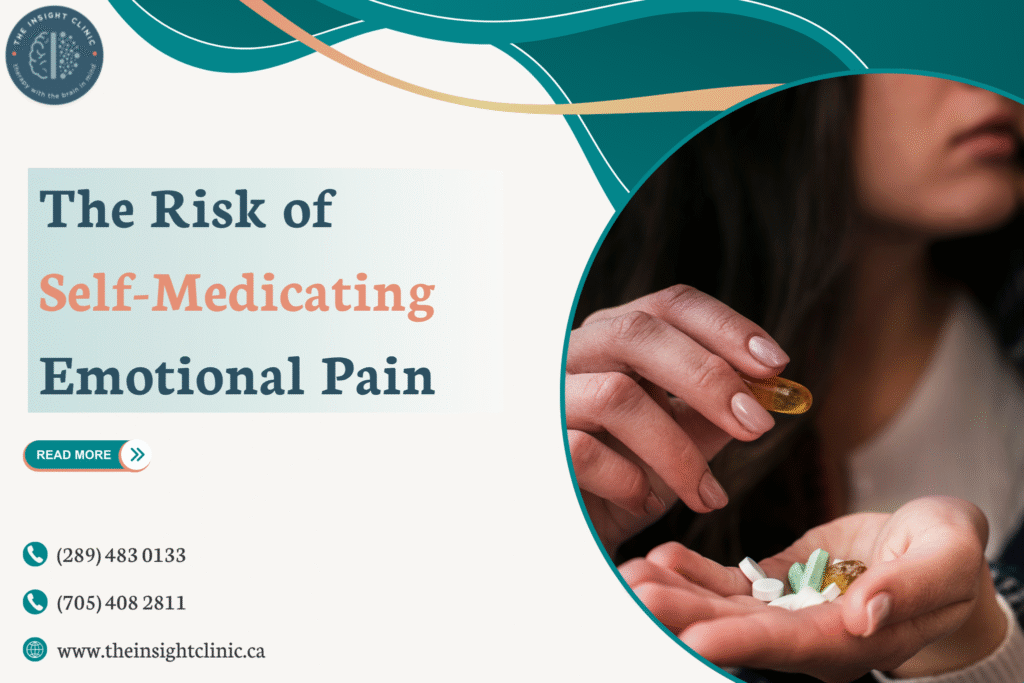People don’t always know what to do with pain that doesn’t show up in bloodwork. They feel something disorganized is unraveling inside them – grief or loneliness or the collapse of their self-worth – and instead of asking for professional help, they’ll reach for something else. Something within arm’s reach, which doesn’t involve paperwork, confessions, or waiting rooms. That is how self-medicating emotional pain begins: often with the best intentions of easing the struggle and in ways that appear almost rational to someone who has (allegedly) run out of other options.
It might look like a drink after work that becomes two or three or four, or a few sleeping pills on weekends that eventually seep into weekdays. Nobody thinks they’re becoming dependent. They usually think they’re managing. The problem is that emotional wounds won’t close just because you’ve stopped looking at them.

Why People Choose the Shortcut
Most people don’t believe emotional pain qualifies as a medical condition. It’s personal and feels like something to be endured or hidden or fixed with distraction. You don’t go to urgent care because your brain (and heart) won’t stop replaying a breakup. You probably won’t schedule a psychiatrist because your confidence crumbled after getting laid off (as the reaction seems fairly natural).
The idea of going DIY on emotional suffering is baked into cultural expectations. Be strong. Figure it out. Push through the pain. So when a person is feeling cracked open and doesn’t know how to close themselves back up, they’ll reach for things that promise quick remedy: alcohol, marijuana, benzodiazepines. A growing body of evidence, including a research study published by the National Library of Medicine, suggests many people don’t consult a physician for emotional pain because they assume their problem isn’t serious enough and that they don’t want to waste anyone’s time, including their own. It seems some would rather risk harm than speak to someone trained to help. In the following chapters, we’ll see exactly why that’s no good.

The Risk of Self-Medicating Emotional Pain
The phrase itself (self-medication) might sound clean, even positive, but the practice is chaotic, messy, and often invisible to others until it has become something serious. These risks rarely show up all at once. And by the time someone has noticed, the damage might’ve already started to settle into routine.
You Could Build a Dependency Without Realizing It
People don’t usually set out to develop an addiction. Alcohol or drugs often enter the picture as a way to cope—something to take the edge off stress, anxiety, or unresolved grief. At first, it seems manageable. A drink helps take the pressure off. A pill makes emotions easier to block out. But over time, what began as occasional relief turns into a routine. The person doesn’t feel out of control—they just feel more like themselves when they use. That’s when emotional self-medication starts turning into something deeper.
One of the biggest risks is how subtle this shift can be. Many people overlook the warning signs of substance abuse because their lives still look functional from the outside. They still show up for work. They keep commitments. But under the surface, things begin to shift. Increased secrecy or isolation, changes in daily motivation, mood swings, and a higher tolerance can all be early signs of dependency. These behavioral changes matter. Spotting them early creates an opportunity to step in before things spiral further. Dependency often develops quietly, and recognizing the signs early is the first real step toward regaining control.
Doses Don’t Come with Instruction Manuals
Prescriptions come with directions for a reason. Most people who are self-medicating emotional pain don’t track how much they’ve taken. They go by feel. By habit. By desperation. And what works one week might stop working the next, which is when they might increase the dose, often without even thinking about it.
The risk here is simple and severe: too much of something that calms you can also shut you down. The central nervous system doesn’t distinguish between recreational and accidental overdose. It reacts to the chemistry, not the story behind it.
Making the Wound Deeper When Trying to Close It
People assume that if something numbs the pain, it must be taking care of the problem. That is a dangerous misunderstanding. Substances might temporarily mute the symptoms of emotional pain, but they’ll keep people from engaging with the underlying cause. In that silence, the original pain can grow more complex.
Imagine someone who feels abandoned and uses alcohol to push that ache away. Each drink delays the confrontation, and as days turn into months, they may begin to develop anxiety or mood swings directly linked to their alcohol use. What started as a self-help strategy now carries its side effects, which often mimic the original emotional pain they were trying to quiet.
Unwanted Side Effects You Never Saw Coming
Even if dependency never develops, substances carry risks – many of them unpredictable. What calms one person may induce paranoia in another. What soothes a broken heart in one dose may trigger insomnia or gastrointestinal issues in someone else.
Some drugs interact with medications a person might already be taking. Others intensify depressive symptoms. Because these choices are made without medical oversight, people often dismiss these effects or don’t trace them back to the real cause. Emotional pain blurs judgment, and that special kind of confusion makes it even harder to notice when your solution has started to cause more harm than the original problem.

What Works Better Than Numbing the Pain
It feels unfair that healing emotional pain takes longer than dulling it. But the longer road is also the safer one. Talking to a mental health professional won’t provide you with immediate relief. But you’ll get clarity. Therapy untangles the pain slowly but permanently. It creates a plan.
Some people who choose to self-medicate say they do it because they feel alone. And that is exactly what therapy or structured support addresses – not just the symptoms but the underlying sense of being isolated or unfixable. Group therapy, individual counseling, even crisis hotlines – they all offer something no drug can do: the experience of being heard by another person without judgment or risk.
There is also value in non-substance strategies for managing emotional pain: regular sleep, movement, boundaries, and creative expression. Even though these might sound like minor acts, they’ll help create consistency in a life that feels unstable. They’ll give it a structure, and with structure comes healing.
You Don’t Have to Hurt This Quietly
The most dangerous thing about self-medicating emotional pain is how easy it is to start. Nobody plans to spiral. They just want to feel better. But substances that seem comforting in small doses can become disruptive over time, especially when used to treat emotions no one else can see.
It is possible to treat emotional pain without causing yourself further harm. It requires effort, time, and the courage to admit when things feel unbearable. But there are professionals trained for exactly that moment. What seems unspeakable doesn’t have to stay that way. Emotional pain is real. And healing should never ever be a solo experiment.
